Comprehensive Care Plan: Applying Nursing Process for Elderly Patients
VerifiedAdded on 2020/06/06
|14
|4172
|129
Report
AI Summary
This report presents a detailed care plan for a 92-year-old patient named Evelyn, residing in a care home and suffering from osteoarthritis, short-term memory loss, gastric reflux, and Alzheimer's disease. The care plan addresses her medical conditions and the medications prescribed. The report emphasizes person-centered care (PCC), highlighting its advantages in improving patient satisfaction, promoting healthy lifestyles, and influencing health outcomes. It explores the McCormac & McCance framework for person-centered nursing, focusing on leadership styles and their impact on service delivery. The main body of the report outlines the nursing process, including assessment, diagnosis, implementation, and evaluation, specifically tailored to Evelyn's case following a hip fracture. The assessment covers physical and psychological aspects, while the diagnosis identifies her health issues. Implementation focuses on applying the care plan, and evaluation assesses the patient's condition. The report also discusses the importance of effective communication in healthcare organizations and the role of care planning in ensuring patient safety and well-being. The document provides a comprehensive analysis of the nursing process and its application in caring for elderly patients with complex health needs within a care home setting.
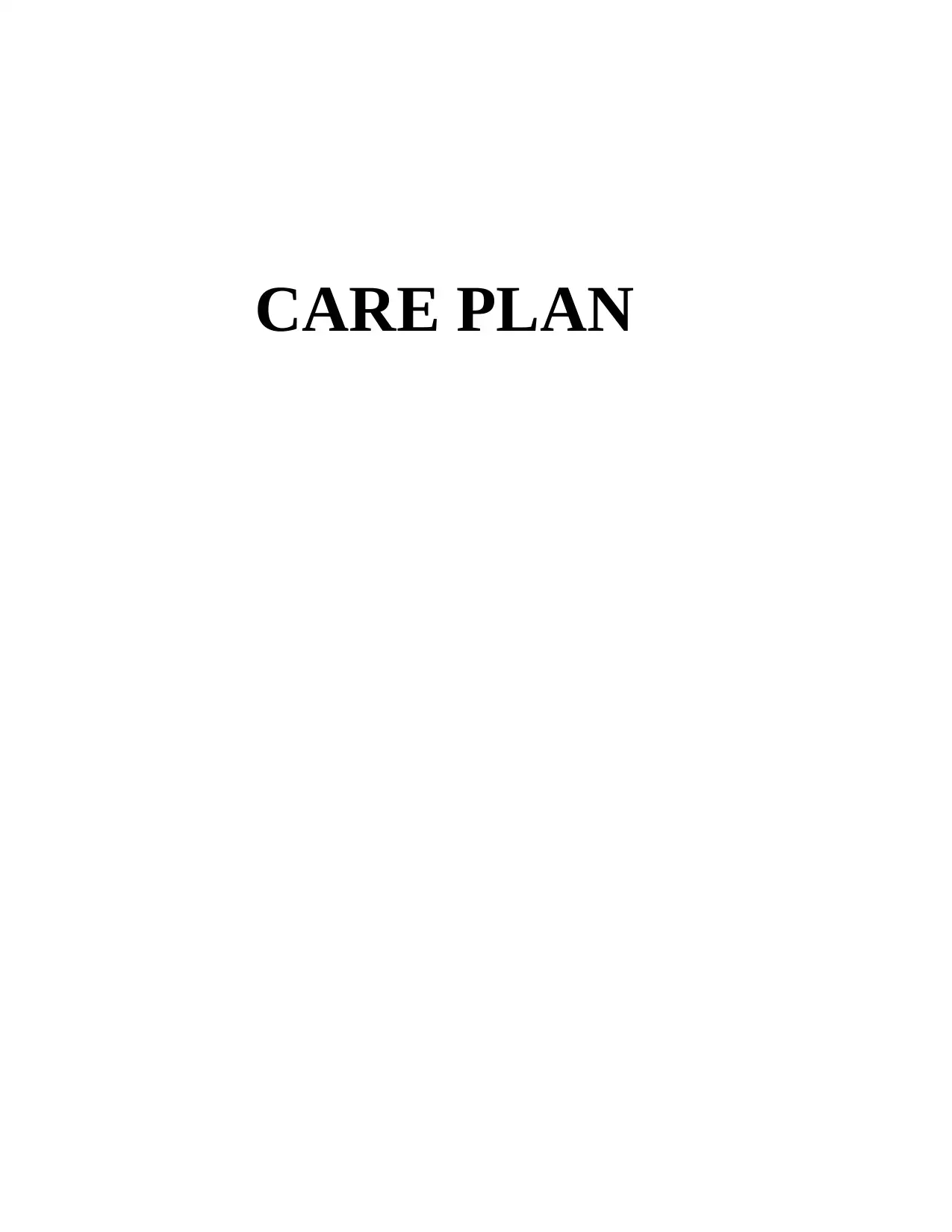
CARE PLAN
Paraphrase This Document
Need a fresh take? Get an instant paraphrase of this document with our AI Paraphraser
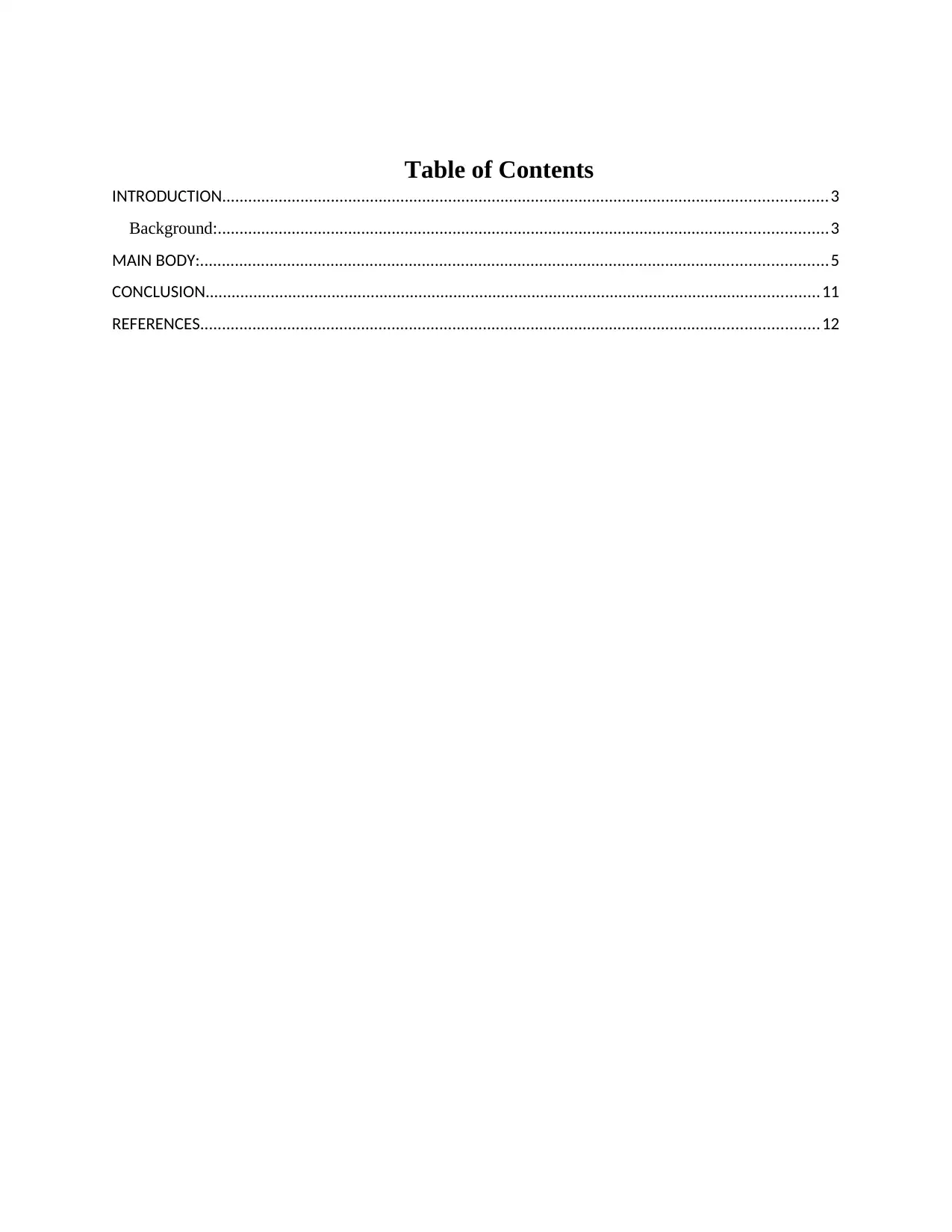
Table of Contents
INTRODUCTION...........................................................................................................................................3
Background:............................................................................................................................................3
MAIN BODY:................................................................................................................................................5
CONCLUSION.............................................................................................................................................11
REFERENCES..............................................................................................................................................12
INTRODUCTION...........................................................................................................................................3
Background:............................................................................................................................................3
MAIN BODY:................................................................................................................................................5
CONCLUSION.............................................................................................................................................11
REFERENCES..............................................................................................................................................12

INTRODUCTION
The present project is related to an elder lady whose name is Evelyn and she is 92 years old.
Now she is residing in a care home. She was suffering from osteoarthritis, short term memory
loss, gastric reflux and Alzheimer’s disease. In order to treating such diseases or getting relief
from those diseases, she was taking treatment and also consuming different drugs for curing
prescribed by health professionals. She has been taking the following listed drugs such as;
Paracetamol 1g 4 times in a day as required, Donepezil 10 mg at night after taking dinner,
Zopiclone 3.75 mg at night, Omeprazole 40 mg one time in a day, Calcichew-D3 forte 1 tablet
two times in a day (Papastavrou Andreou and Efstathiou, 2014).
According to the given case study, one day, she met with an accident and faces severe
injuries involving swelling to her left hip. Apart from this, her legs get externally rotated during
falling down at her bathroom. Due to internal rotation of her legs, few noticeable shortcomings
happened in the limb. She was suffering from extreme pain in her left hip and because of this
reason, she has admitted in the care home. She was not in conscious state at the time of admitting
in the hospital and even after that she was also not awaked about why she was being admitted. In
this assignment, various set standards are designed effectively so that the caretaker can provide
her proper caring throughout the observation in the rest home.
Background:
Person centred care is the way or mode of assessing and undertaking actions that overview the
person executing health and social care services as the same partners in scheduling, promising
and controlling care to make certain that it will meet their requests (Dening, Jones and Sampson,
2011). This simply refers to put citizens and their family members at the core of decision making
process and cross checking them as an expert, working furthermore health professionals to get
the most excellent outcome.
Person centred care is not only about offering public anything they require or rendering
information. But this is about adopting needs of people, ethics, situations of families, societal
situations and living styles, examining person, and working together to come out a satisfactory
solution. Being concerned, it can be said that it is nothing but observing about the effects or any
The present project is related to an elder lady whose name is Evelyn and she is 92 years old.
Now she is residing in a care home. She was suffering from osteoarthritis, short term memory
loss, gastric reflux and Alzheimer’s disease. In order to treating such diseases or getting relief
from those diseases, she was taking treatment and also consuming different drugs for curing
prescribed by health professionals. She has been taking the following listed drugs such as;
Paracetamol 1g 4 times in a day as required, Donepezil 10 mg at night after taking dinner,
Zopiclone 3.75 mg at night, Omeprazole 40 mg one time in a day, Calcichew-D3 forte 1 tablet
two times in a day (Papastavrou Andreou and Efstathiou, 2014).
According to the given case study, one day, she met with an accident and faces severe
injuries involving swelling to her left hip. Apart from this, her legs get externally rotated during
falling down at her bathroom. Due to internal rotation of her legs, few noticeable shortcomings
happened in the limb. She was suffering from extreme pain in her left hip and because of this
reason, she has admitted in the care home. She was not in conscious state at the time of admitting
in the hospital and even after that she was also not awaked about why she was being admitted. In
this assignment, various set standards are designed effectively so that the caretaker can provide
her proper caring throughout the observation in the rest home.
Background:
Person centred care is the way or mode of assessing and undertaking actions that overview the
person executing health and social care services as the same partners in scheduling, promising
and controlling care to make certain that it will meet their requests (Dening, Jones and Sampson,
2011). This simply refers to put citizens and their family members at the core of decision making
process and cross checking them as an expert, working furthermore health professionals to get
the most excellent outcome.
Person centred care is not only about offering public anything they require or rendering
information. But this is about adopting needs of people, ethics, situations of families, societal
situations and living styles, examining person, and working together to come out a satisfactory
solution. Being concerned, it can be said that it is nothing but observing about the effects or any
⊘ This is a preview!⊘
Do you want full access?
Subscribe today to unlock all pages.

Trusted by 1+ million students worldwide
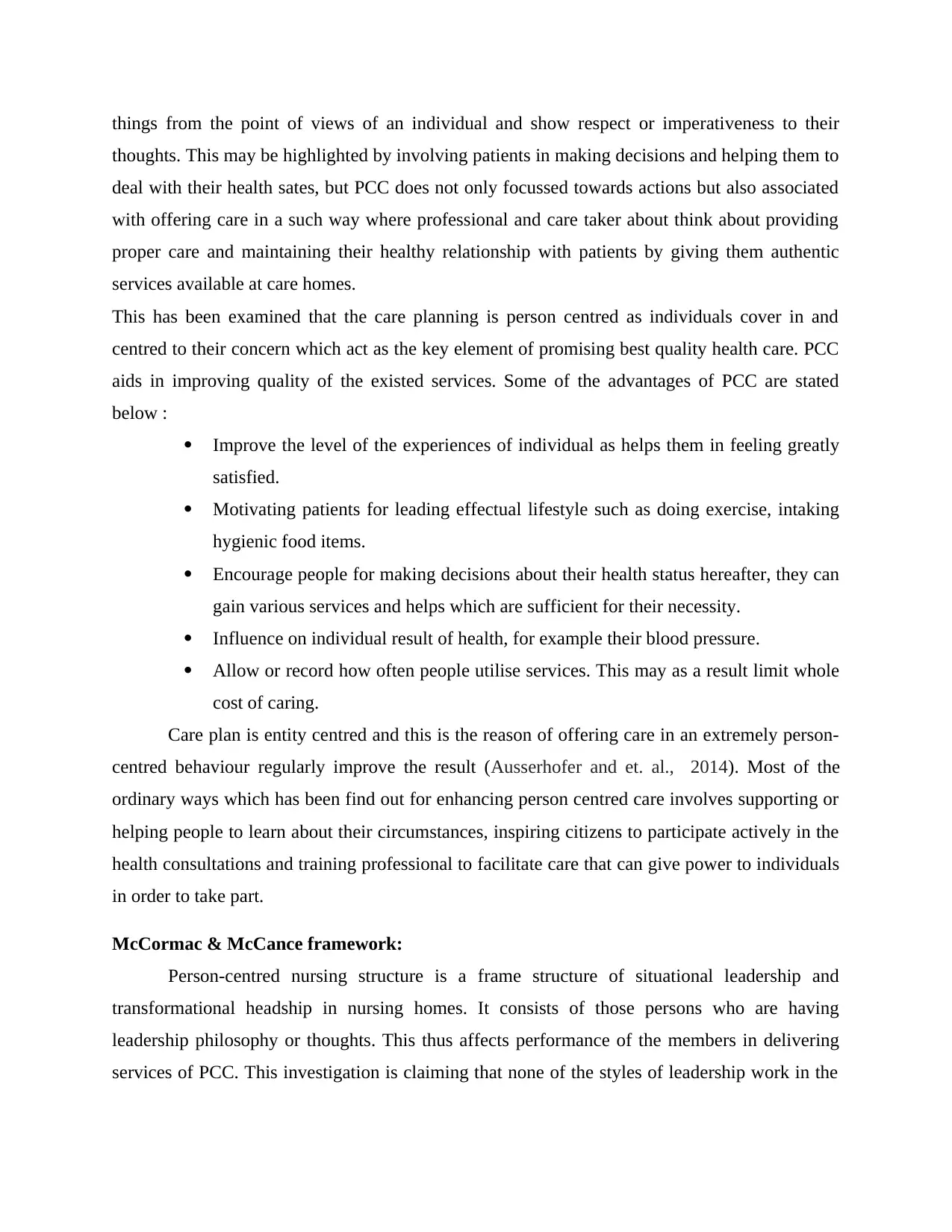
things from the point of views of an individual and show respect or imperativeness to their
thoughts. This may be highlighted by involving patients in making decisions and helping them to
deal with their health sates, but PCC does not only focussed towards actions but also associated
with offering care in a such way where professional and care taker about think about providing
proper care and maintaining their healthy relationship with patients by giving them authentic
services available at care homes.
This has been examined that the care planning is person centred as individuals cover in and
centred to their concern which act as the key element of promising best quality health care. PCC
aids in improving quality of the existed services. Some of the advantages of PCC are stated
below :
Improve the level of the experiences of individual as helps them in feeling greatly
satisfied.
Motivating patients for leading effectual lifestyle such as doing exercise, intaking
hygienic food items.
Encourage people for making decisions about their health status hereafter, they can
gain various services and helps which are sufficient for their necessity.
Influence on individual result of health, for example their blood pressure.
Allow or record how often people utilise services. This may as a result limit whole
cost of caring.
Care plan is entity centred and this is the reason of offering care in an extremely person-
centred behaviour regularly improve the result (Ausserhofer and et. al., 2014). Most of the
ordinary ways which has been find out for enhancing person centred care involves supporting or
helping people to learn about their circumstances, inspiring citizens to participate actively in the
health consultations and training professional to facilitate care that can give power to individuals
in order to take part.
McCormac & McCance framework:
Person-centred nursing structure is a frame structure of situational leadership and
transformational headship in nursing homes. It consists of those persons who are having
leadership philosophy or thoughts. This thus affects performance of the members in delivering
services of PCC. This investigation is claiming that none of the styles of leadership work in the
thoughts. This may be highlighted by involving patients in making decisions and helping them to
deal with their health sates, but PCC does not only focussed towards actions but also associated
with offering care in a such way where professional and care taker about think about providing
proper care and maintaining their healthy relationship with patients by giving them authentic
services available at care homes.
This has been examined that the care planning is person centred as individuals cover in and
centred to their concern which act as the key element of promising best quality health care. PCC
aids in improving quality of the existed services. Some of the advantages of PCC are stated
below :
Improve the level of the experiences of individual as helps them in feeling greatly
satisfied.
Motivating patients for leading effectual lifestyle such as doing exercise, intaking
hygienic food items.
Encourage people for making decisions about their health status hereafter, they can
gain various services and helps which are sufficient for their necessity.
Influence on individual result of health, for example their blood pressure.
Allow or record how often people utilise services. This may as a result limit whole
cost of caring.
Care plan is entity centred and this is the reason of offering care in an extremely person-
centred behaviour regularly improve the result (Ausserhofer and et. al., 2014). Most of the
ordinary ways which has been find out for enhancing person centred care involves supporting or
helping people to learn about their circumstances, inspiring citizens to participate actively in the
health consultations and training professional to facilitate care that can give power to individuals
in order to take part.
McCormac & McCance framework:
Person-centred nursing structure is a frame structure of situational leadership and
transformational headship in nursing homes. It consists of those persons who are having
leadership philosophy or thoughts. This thus affects performance of the members in delivering
services of PCC. This investigation is claiming that none of the styles of leadership work in the
Paraphrase This Document
Need a fresh take? Get an instant paraphrase of this document with our AI Paraphraser
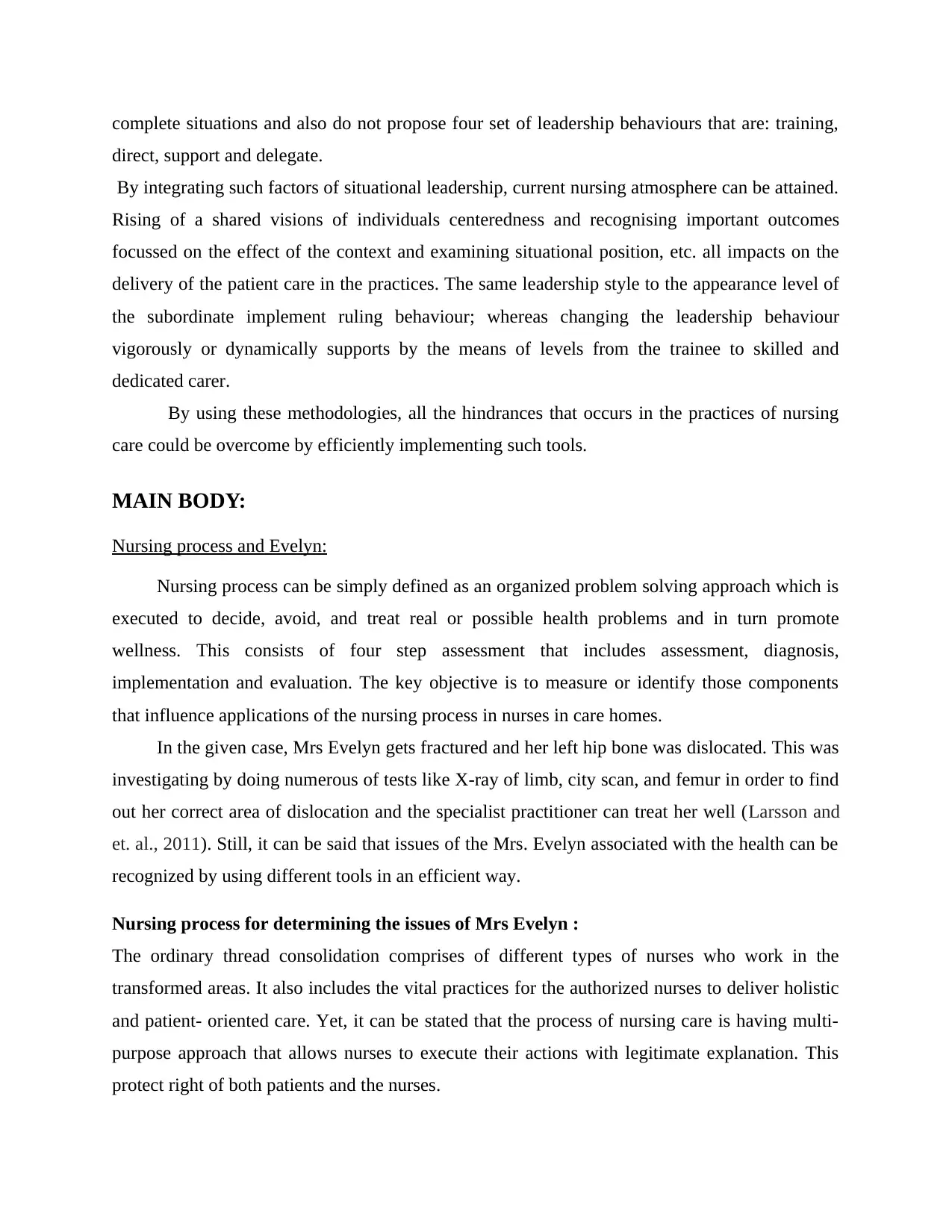
complete situations and also do not propose four set of leadership behaviours that are: training,
direct, support and delegate.
By integrating such factors of situational leadership, current nursing atmosphere can be attained.
Rising of a shared visions of individuals centeredness and recognising important outcomes
focussed on the effect of the context and examining situational position, etc. all impacts on the
delivery of the patient care in the practices. The same leadership style to the appearance level of
the subordinate implement ruling behaviour; whereas changing the leadership behaviour
vigorously or dynamically supports by the means of levels from the trainee to skilled and
dedicated carer.
By using these methodologies, all the hindrances that occurs in the practices of nursing
care could be overcome by efficiently implementing such tools.
MAIN BODY:
Nursing process and Evelyn:
Nursing process can be simply defined as an organized problem solving approach which is
executed to decide, avoid, and treat real or possible health problems and in turn promote
wellness. This consists of four step assessment that includes assessment, diagnosis,
implementation and evaluation. The key objective is to measure or identify those components
that influence applications of the nursing process in nurses in care homes.
In the given case, Mrs Evelyn gets fractured and her left hip bone was dislocated. This was
investigating by doing numerous of tests like X-ray of limb, city scan, and femur in order to find
out her correct area of dislocation and the specialist practitioner can treat her well (Larsson and
et. al., 2011). Still, it can be said that issues of the Mrs. Evelyn associated with the health can be
recognized by using different tools in an efficient way.
Nursing process for determining the issues of Mrs Evelyn :
The ordinary thread consolidation comprises of different types of nurses who work in the
transformed areas. It also includes the vital practices for the authorized nurses to deliver holistic
and patient- oriented care. Yet, it can be stated that the process of nursing care is having multi-
purpose approach that allows nurses to execute their actions with legitimate explanation. This
protect right of both patients and the nurses.
direct, support and delegate.
By integrating such factors of situational leadership, current nursing atmosphere can be attained.
Rising of a shared visions of individuals centeredness and recognising important outcomes
focussed on the effect of the context and examining situational position, etc. all impacts on the
delivery of the patient care in the practices. The same leadership style to the appearance level of
the subordinate implement ruling behaviour; whereas changing the leadership behaviour
vigorously or dynamically supports by the means of levels from the trainee to skilled and
dedicated carer.
By using these methodologies, all the hindrances that occurs in the practices of nursing
care could be overcome by efficiently implementing such tools.
MAIN BODY:
Nursing process and Evelyn:
Nursing process can be simply defined as an organized problem solving approach which is
executed to decide, avoid, and treat real or possible health problems and in turn promote
wellness. This consists of four step assessment that includes assessment, diagnosis,
implementation and evaluation. The key objective is to measure or identify those components
that influence applications of the nursing process in nurses in care homes.
In the given case, Mrs Evelyn gets fractured and her left hip bone was dislocated. This was
investigating by doing numerous of tests like X-ray of limb, city scan, and femur in order to find
out her correct area of dislocation and the specialist practitioner can treat her well (Larsson and
et. al., 2011). Still, it can be said that issues of the Mrs. Evelyn associated with the health can be
recognized by using different tools in an efficient way.
Nursing process for determining the issues of Mrs Evelyn :
The ordinary thread consolidation comprises of different types of nurses who work in the
transformed areas. It also includes the vital practices for the authorized nurses to deliver holistic
and patient- oriented care. Yet, it can be stated that the process of nursing care is having multi-
purpose approach that allows nurses to execute their actions with legitimate explanation. This
protect right of both patients and the nurses.

Assessment: An enumerated nurse uses planned, vigorous manner to collect and evaluate data
about a customer, this is the first step of delivering nursing care. Assessment includes
psychosomatic, socio - cultural, non-physical, financial, and life cycle components as well. For
example, a nurse's assessment of a Mrs Evelyn and other patients involves physical causes and
appearances of discomfort, but Evelyn reply- a helplessness to get out of the couch, rejection to
consume food, impoliteness on the workers, or complex pain medication. Thus, assessment could
be done by asking from the clients about the concerns or problems they have. Listed nurses can
create plan consequently.
Mrs. Evelyn during the surveillance was found insensible and from her previous medicinal
reports, this has been detected that she was having gastrointestinal reflux, osteoporosis,
osteoarthritis and Alzheimer’s disease. At the time of observation, she was having: BP 121/73
which appears to be the ordinary; pulse rate was 96; physique temperature was 37.6°C; SPO2
98%; VAS pain marked10/10 on the measure. This imitates that everything is normal but she
was cataleptic and when she wakes up then she found herself in a sick bay and urinary tube was
attached to her and also arterial juices running.
Diagnosis: It simply refers to the clinical judgement provided by nurses about the patient's
response to the real health situations. The diagnosis reveals that not only the client is in suffering
or troubles but also that discovers pain which causes other varied problems such as absence of
nutrition, nervousness and concerns within the family members, or has potential of causing
difficulties. For example, respiratory infection is a most nominal risk to an immobilised or
powerless patient. This diagnosis is the ultimate factor for the nursing care plan so that they can
recognise their diseases in an active means. Analysis of the disease in patient is investigated by
technique of using definite medical equipment so that the people may know about their current
health condition. In this case, the doctor perceived that the patient is having gastric problems and
she also suffers from different diseases like osteoarthritis, osteoporosis and amzhimer’s disease.
This could only be controlled by using several medicines such as: Calcichew-D3 forte is going to
remove ostia related problems like osteoarthritis and osteoporosis; besides this, gastric
interrelated difficulties can be treated by consuming omeprazole pills; Alzheimer’s associated
complications and short term memory loss might be recovered by using donepezil and Zopiclone
drugs (Rothärmel and et. al., 2011). But now she is having severe ache for which she was
admitted in hospital under observation.
about a customer, this is the first step of delivering nursing care. Assessment includes
psychosomatic, socio - cultural, non-physical, financial, and life cycle components as well. For
example, a nurse's assessment of a Mrs Evelyn and other patients involves physical causes and
appearances of discomfort, but Evelyn reply- a helplessness to get out of the couch, rejection to
consume food, impoliteness on the workers, or complex pain medication. Thus, assessment could
be done by asking from the clients about the concerns or problems they have. Listed nurses can
create plan consequently.
Mrs. Evelyn during the surveillance was found insensible and from her previous medicinal
reports, this has been detected that she was having gastrointestinal reflux, osteoporosis,
osteoarthritis and Alzheimer’s disease. At the time of observation, she was having: BP 121/73
which appears to be the ordinary; pulse rate was 96; physique temperature was 37.6°C; SPO2
98%; VAS pain marked10/10 on the measure. This imitates that everything is normal but she
was cataleptic and when she wakes up then she found herself in a sick bay and urinary tube was
attached to her and also arterial juices running.
Diagnosis: It simply refers to the clinical judgement provided by nurses about the patient's
response to the real health situations. The diagnosis reveals that not only the client is in suffering
or troubles but also that discovers pain which causes other varied problems such as absence of
nutrition, nervousness and concerns within the family members, or has potential of causing
difficulties. For example, respiratory infection is a most nominal risk to an immobilised or
powerless patient. This diagnosis is the ultimate factor for the nursing care plan so that they can
recognise their diseases in an active means. Analysis of the disease in patient is investigated by
technique of using definite medical equipment so that the people may know about their current
health condition. In this case, the doctor perceived that the patient is having gastric problems and
she also suffers from different diseases like osteoarthritis, osteoporosis and amzhimer’s disease.
This could only be controlled by using several medicines such as: Calcichew-D3 forte is going to
remove ostia related problems like osteoarthritis and osteoporosis; besides this, gastric
interrelated difficulties can be treated by consuming omeprazole pills; Alzheimer’s associated
complications and short term memory loss might be recovered by using donepezil and Zopiclone
drugs (Rothärmel and et. al., 2011). But now she is having severe ache for which she was
admitted in hospital under observation.
⊘ This is a preview!⊘
Do you want full access?
Subscribe today to unlock all pages.

Trusted by 1+ million students worldwide

Implementation- Nursing care has been applied as per the care planning and also care
consistency for the patients at the time of admission and ready for providing discharge at the
time when it is required. It is important for company is to take care of patients documents at the
time of record patient details. While understanding the specific issues and problems of the
patient, the registered nurse applies for their rational practices for doing effective practicing in
proper manner (Hockenberry and Wilson, 2014). This is necessary to implemented firm
procedure because it is very effective method that can easily applied by the nurse so that Mrs.
Evelyn has major issues and problems which can be overcome these factors. When executing the
nursing care planning, patient consistency has been seen in the hospitalization of the patient.
Evaluation- There are many patient whose condition and efficiency of the nursing care that
required to be daily evaluated and also care plan will be change as per the demand and
requirements of patients. it is very important for making effective methods and tools which can
made some tool and such tools has been provided many methods in proper manner. After
understanding and evaluating patient's condition and problems, there should be some routine
assessment which has to be done in terms of blood sugar, blood pressure and some others. Mr.
Evelyn regular assessment should be done by registered nurses within the hospital so they can
properly analyze them in effective manner (Ackley, Ladwig and Makic, 2016). For
implementing process of nursing, so evaluating method can be done in appropriate manner and
also hospital management can make so9me strategy which relates to hospital management and
administration.
Nursing care plan-
In the health care organization, oral reports, handoffs, health information technology,
HER, conferences are needed for proper flow of effective information. In simple words, care
planning process is that structure which requires framework for cope communication that can
help in emerging the health and safety process in better manner. also care planning process
define as those structure which can used for coordinating and cooperating communication which
can emerges safety in effective way. On the other hand, the patient care department is another
major thoughts, interventions and study to examine related issues and problems that can help in
protecting patients from any disease. The key sub division of patient care planning should
improved planning care, management and critical portfolio for maintaining danger diseases. Care
consistency for the patients at the time of admission and ready for providing discharge at the
time when it is required. It is important for company is to take care of patients documents at the
time of record patient details. While understanding the specific issues and problems of the
patient, the registered nurse applies for their rational practices for doing effective practicing in
proper manner (Hockenberry and Wilson, 2014). This is necessary to implemented firm
procedure because it is very effective method that can easily applied by the nurse so that Mrs.
Evelyn has major issues and problems which can be overcome these factors. When executing the
nursing care planning, patient consistency has been seen in the hospitalization of the patient.
Evaluation- There are many patient whose condition and efficiency of the nursing care that
required to be daily evaluated and also care plan will be change as per the demand and
requirements of patients. it is very important for making effective methods and tools which can
made some tool and such tools has been provided many methods in proper manner. After
understanding and evaluating patient's condition and problems, there should be some routine
assessment which has to be done in terms of blood sugar, blood pressure and some others. Mr.
Evelyn regular assessment should be done by registered nurses within the hospital so they can
properly analyze them in effective manner (Ackley, Ladwig and Makic, 2016). For
implementing process of nursing, so evaluating method can be done in appropriate manner and
also hospital management can make so9me strategy which relates to hospital management and
administration.
Nursing care plan-
In the health care organization, oral reports, handoffs, health information technology,
HER, conferences are needed for proper flow of effective information. In simple words, care
planning process is that structure which requires framework for cope communication that can
help in emerging the health and safety process in better manner. also care planning process
define as those structure which can used for coordinating and cooperating communication which
can emerges safety in effective way. On the other hand, the patient care department is another
major thoughts, interventions and study to examine related issues and problems that can help in
protecting patients from any disease. The key sub division of patient care planning should
improved planning care, management and critical portfolio for maintaining danger diseases. Care
Paraphrase This Document
Need a fresh take? Get an instant paraphrase of this document with our AI Paraphraser
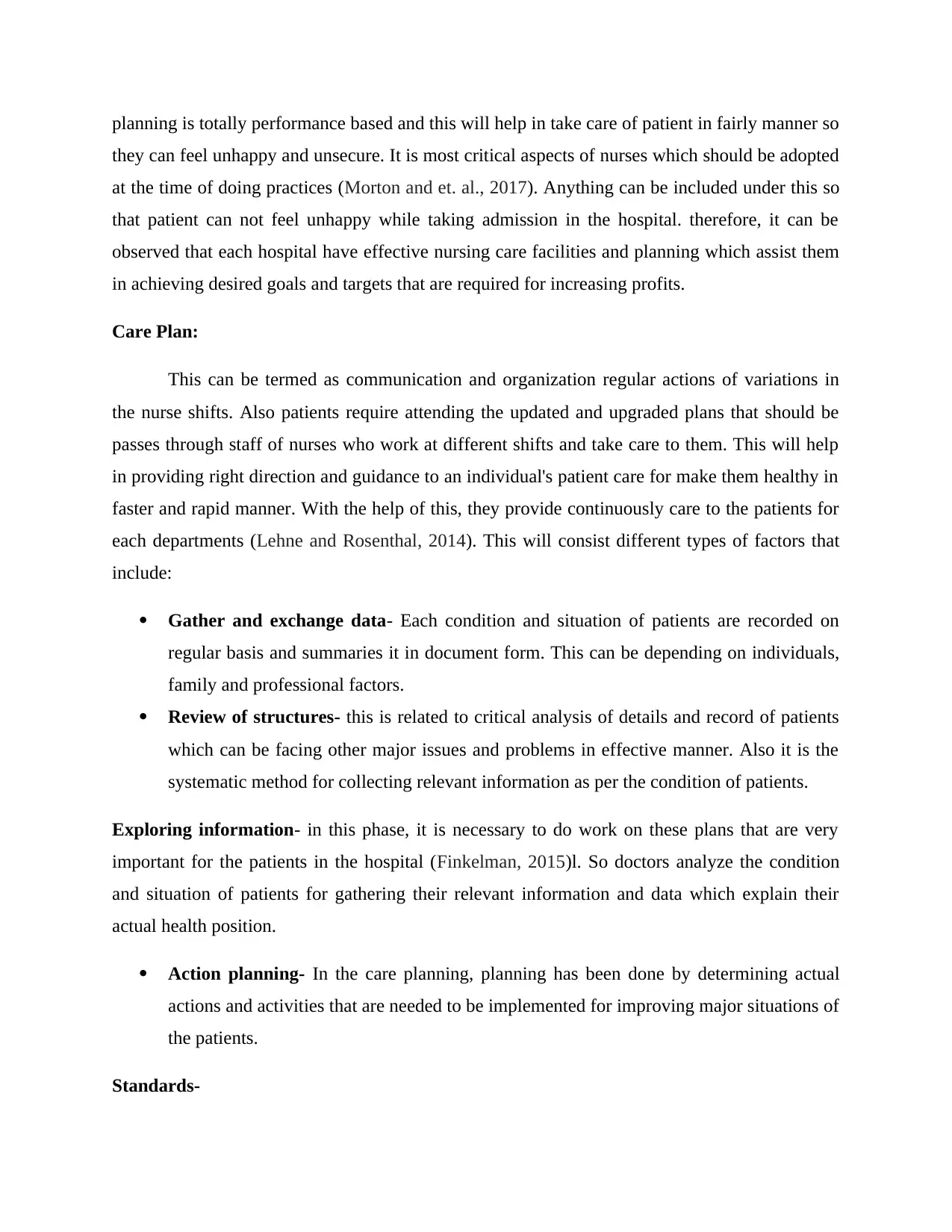
planning is totally performance based and this will help in take care of patient in fairly manner so
they can feel unhappy and unsecure. It is most critical aspects of nurses which should be adopted
at the time of doing practices (Morton and et. al., 2017). Anything can be included under this so
that patient can not feel unhappy while taking admission in the hospital. therefore, it can be
observed that each hospital have effective nursing care facilities and planning which assist them
in achieving desired goals and targets that are required for increasing profits.
Care Plan:
This can be termed as communication and organization regular actions of variations in
the nurse shifts. Also patients require attending the updated and upgraded plans that should be
passes through staff of nurses who work at different shifts and take care to them. This will help
in providing right direction and guidance to an individual's patient care for make them healthy in
faster and rapid manner. With the help of this, they provide continuously care to the patients for
each departments (Lehne and Rosenthal, 2014). This will consist different types of factors that
include:
Gather and exchange data- Each condition and situation of patients are recorded on
regular basis and summaries it in document form. This can be depending on individuals,
family and professional factors.
Review of structures- this is related to critical analysis of details and record of patients
which can be facing other major issues and problems in effective manner. Also it is the
systematic method for collecting relevant information as per the condition of patients.
Exploring information- in this phase, it is necessary to do work on these plans that are very
important for the patients in the hospital (Finkelman, 2015)l. So doctors analyze the condition
and situation of patients for gathering their relevant information and data which explain their
actual health position.
Action planning- In the care planning, planning has been done by determining actual
actions and activities that are needed to be implemented for improving major situations of
the patients.
Standards-
they can feel unhappy and unsecure. It is most critical aspects of nurses which should be adopted
at the time of doing practices (Morton and et. al., 2017). Anything can be included under this so
that patient can not feel unhappy while taking admission in the hospital. therefore, it can be
observed that each hospital have effective nursing care facilities and planning which assist them
in achieving desired goals and targets that are required for increasing profits.
Care Plan:
This can be termed as communication and organization regular actions of variations in
the nurse shifts. Also patients require attending the updated and upgraded plans that should be
passes through staff of nurses who work at different shifts and take care to them. This will help
in providing right direction and guidance to an individual's patient care for make them healthy in
faster and rapid manner. With the help of this, they provide continuously care to the patients for
each departments (Lehne and Rosenthal, 2014). This will consist different types of factors that
include:
Gather and exchange data- Each condition and situation of patients are recorded on
regular basis and summaries it in document form. This can be depending on individuals,
family and professional factors.
Review of structures- this is related to critical analysis of details and record of patients
which can be facing other major issues and problems in effective manner. Also it is the
systematic method for collecting relevant information as per the condition of patients.
Exploring information- in this phase, it is necessary to do work on these plans that are very
important for the patients in the hospital (Finkelman, 2015)l. So doctors analyze the condition
and situation of patients for gathering their relevant information and data which explain their
actual health position.
Action planning- In the care planning, planning has been done by determining actual
actions and activities that are needed to be implemented for improving major situations of
the patients.
Standards-
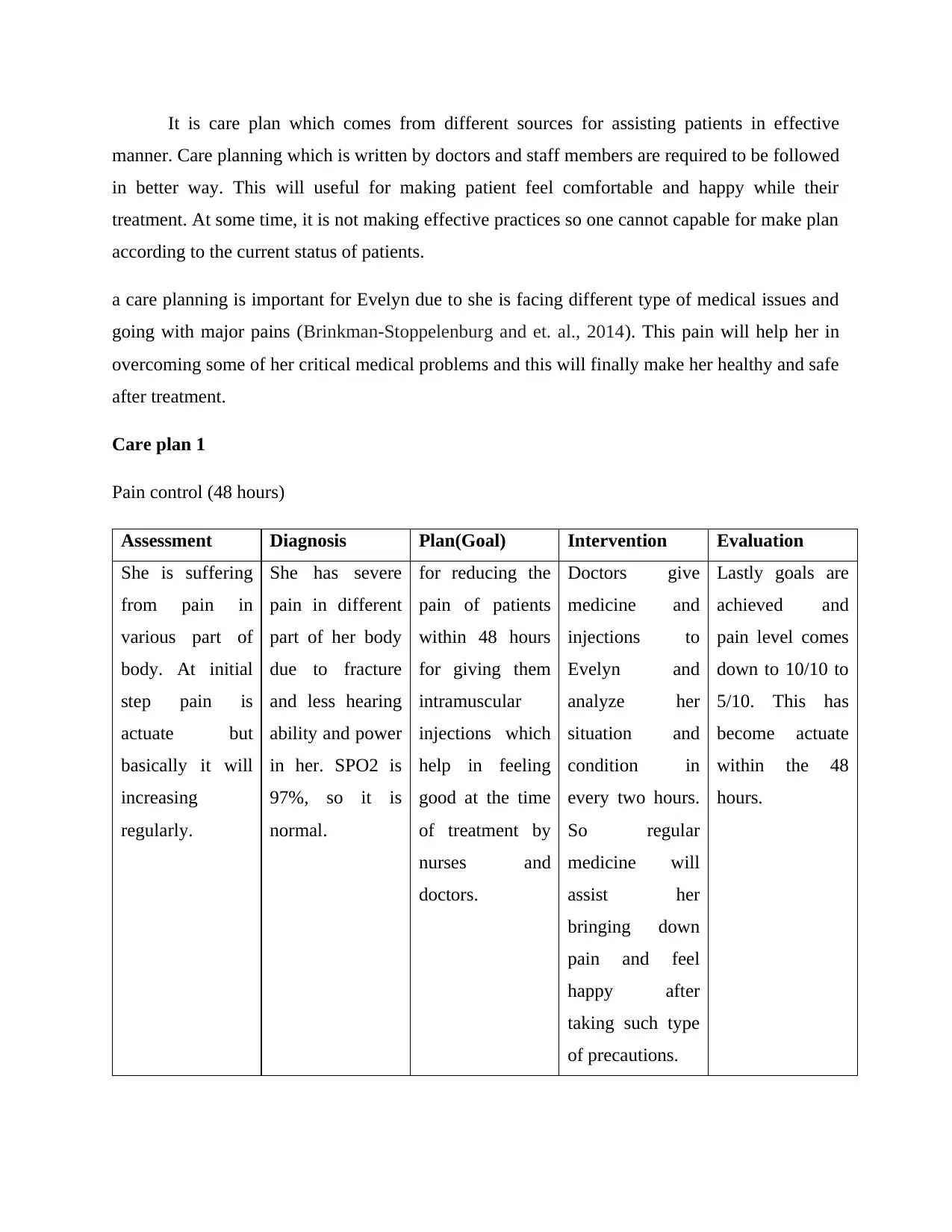
It is care plan which comes from different sources for assisting patients in effective
manner. Care planning which is written by doctors and staff members are required to be followed
in better way. This will useful for making patient feel comfortable and happy while their
treatment. At some time, it is not making effective practices so one cannot capable for make plan
according to the current status of patients.
a care planning is important for Evelyn due to she is facing different type of medical issues and
going with major pains (Brinkman-Stoppelenburg and et. al., 2014). This pain will help her in
overcoming some of her critical medical problems and this will finally make her healthy and safe
after treatment.
Care plan 1
Pain control (48 hours)
Assessment Diagnosis Plan(Goal) Intervention Evaluation
She is suffering
from pain in
various part of
body. At initial
step pain is
actuate but
basically it will
increasing
regularly.
She has severe
pain in different
part of her body
due to fracture
and less hearing
ability and power
in her. SPO2 is
97%, so it is
normal.
for reducing the
pain of patients
within 48 hours
for giving them
intramuscular
injections which
help in feeling
good at the time
of treatment by
nurses and
doctors.
Doctors give
medicine and
injections to
Evelyn and
analyze her
situation and
condition in
every two hours.
So regular
medicine will
assist her
bringing down
pain and feel
happy after
taking such type
of precautions.
Lastly goals are
achieved and
pain level comes
down to 10/10 to
5/10. This has
become actuate
within the 48
hours.
manner. Care planning which is written by doctors and staff members are required to be followed
in better way. This will useful for making patient feel comfortable and happy while their
treatment. At some time, it is not making effective practices so one cannot capable for make plan
according to the current status of patients.
a care planning is important for Evelyn due to she is facing different type of medical issues and
going with major pains (Brinkman-Stoppelenburg and et. al., 2014). This pain will help her in
overcoming some of her critical medical problems and this will finally make her healthy and safe
after treatment.
Care plan 1
Pain control (48 hours)
Assessment Diagnosis Plan(Goal) Intervention Evaluation
She is suffering
from pain in
various part of
body. At initial
step pain is
actuate but
basically it will
increasing
regularly.
She has severe
pain in different
part of her body
due to fracture
and less hearing
ability and power
in her. SPO2 is
97%, so it is
normal.
for reducing the
pain of patients
within 48 hours
for giving them
intramuscular
injections which
help in feeling
good at the time
of treatment by
nurses and
doctors.
Doctors give
medicine and
injections to
Evelyn and
analyze her
situation and
condition in
every two hours.
So regular
medicine will
assist her
bringing down
pain and feel
happy after
taking such type
of precautions.
Lastly goals are
achieved and
pain level comes
down to 10/10 to
5/10. This has
become actuate
within the 48
hours.
⊘ This is a preview!⊘
Do you want full access?
Subscribe today to unlock all pages.

Trusted by 1+ million students worldwide
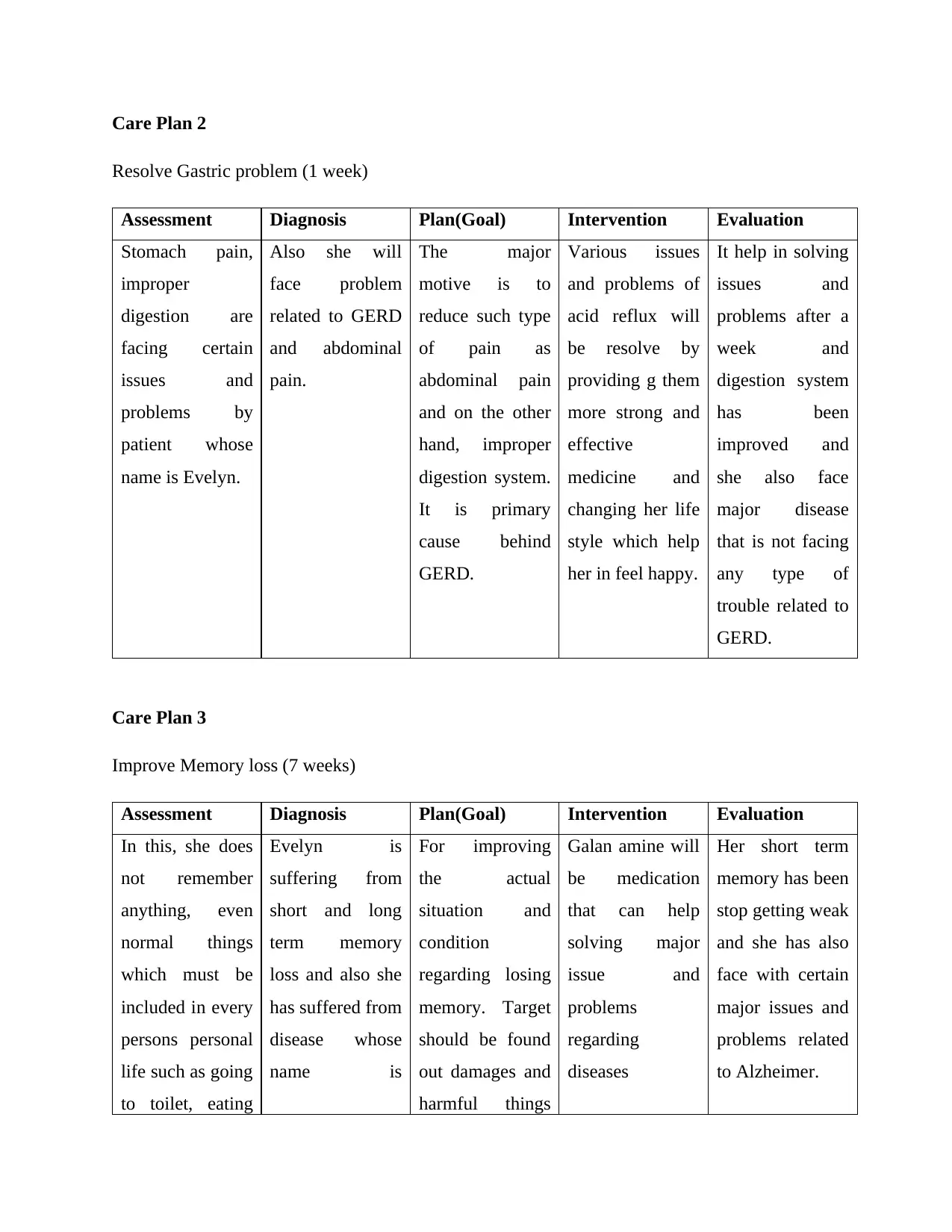
Care Plan 2
Resolve Gastric problem (1 week)
Assessment Diagnosis Plan(Goal) Intervention Evaluation
Stomach pain,
improper
digestion are
facing certain
issues and
problems by
patient whose
name is Evelyn.
Also she will
face problem
related to GERD
and abdominal
pain.
The major
motive is to
reduce such type
of pain as
abdominal pain
and on the other
hand, improper
digestion system.
It is primary
cause behind
GERD.
Various issues
and problems of
acid reflux will
be resolve by
providing g them
more strong and
effective
medicine and
changing her life
style which help
her in feel happy.
It help in solving
issues and
problems after a
week and
digestion system
has been
improved and
she also face
major disease
that is not facing
any type of
trouble related to
GERD.
Care Plan 3
Improve Memory loss (7 weeks)
Assessment Diagnosis Plan(Goal) Intervention Evaluation
In this, she does
not remember
anything, even
normal things
which must be
included in every
persons personal
life such as going
to toilet, eating
Evelyn is
suffering from
short and long
term memory
loss and also she
has suffered from
disease whose
name is
For improving
the actual
situation and
condition
regarding losing
memory. Target
should be found
out damages and
harmful things
Galan amine will
be medication
that can help
solving major
issue and
problems
regarding
diseases
Her short term
memory has been
stop getting weak
and she has also
face with certain
major issues and
problems related
to Alzheimer.
Resolve Gastric problem (1 week)
Assessment Diagnosis Plan(Goal) Intervention Evaluation
Stomach pain,
improper
digestion are
facing certain
issues and
problems by
patient whose
name is Evelyn.
Also she will
face problem
related to GERD
and abdominal
pain.
The major
motive is to
reduce such type
of pain as
abdominal pain
and on the other
hand, improper
digestion system.
It is primary
cause behind
GERD.
Various issues
and problems of
acid reflux will
be resolve by
providing g them
more strong and
effective
medicine and
changing her life
style which help
her in feel happy.
It help in solving
issues and
problems after a
week and
digestion system
has been
improved and
she also face
major disease
that is not facing
any type of
trouble related to
GERD.
Care Plan 3
Improve Memory loss (7 weeks)
Assessment Diagnosis Plan(Goal) Intervention Evaluation
In this, she does
not remember
anything, even
normal things
which must be
included in every
persons personal
life such as going
to toilet, eating
Evelyn is
suffering from
short and long
term memory
loss and also she
has suffered from
disease whose
name is
For improving
the actual
situation and
condition
regarding losing
memory. Target
should be found
out damages and
harmful things
Galan amine will
be medication
that can help
solving major
issue and
problems
regarding
diseases
Her short term
memory has been
stop getting weak
and she has also
face with certain
major issues and
problems related
to Alzheimer.
Paraphrase This Document
Need a fresh take? Get an instant paraphrase of this document with our AI Paraphraser
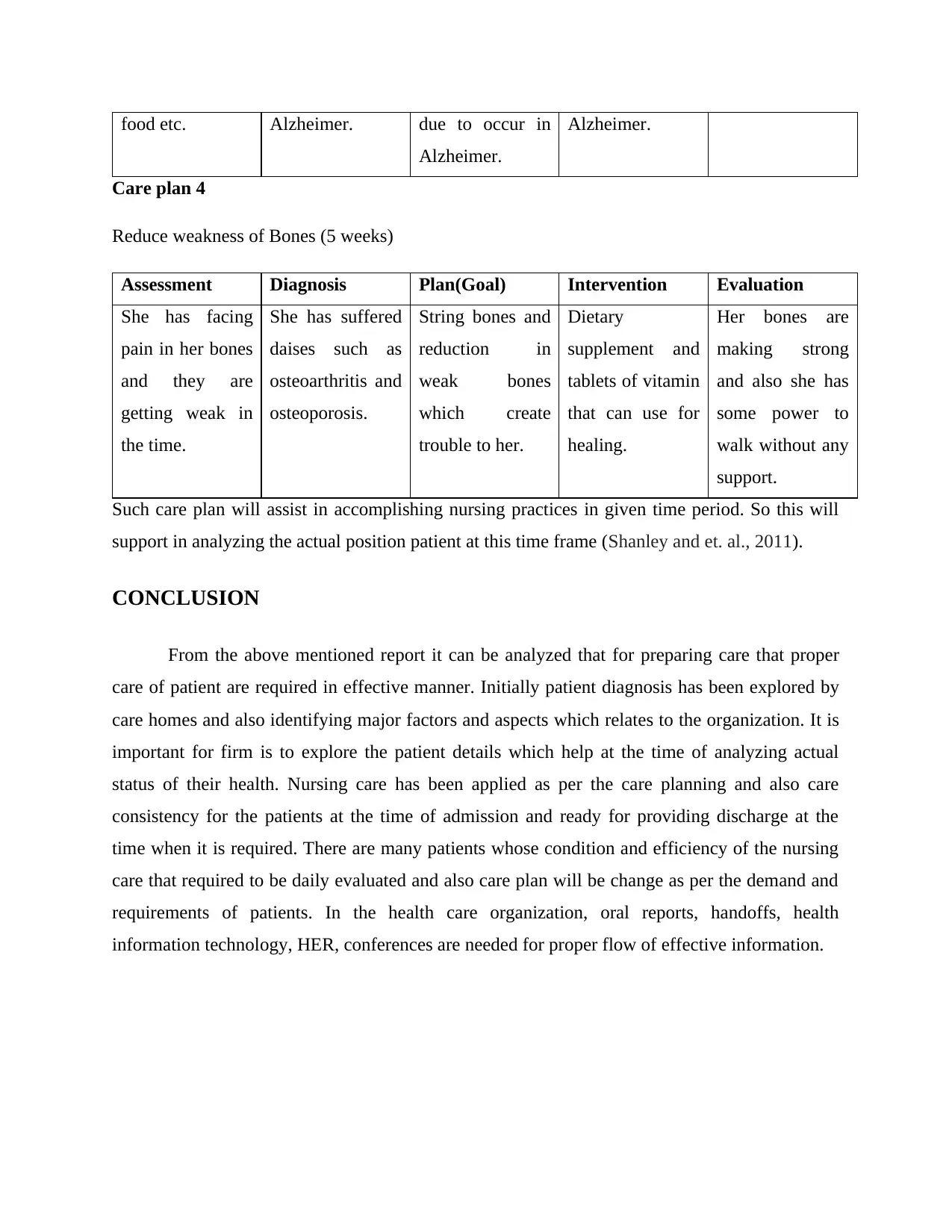
food etc. Alzheimer. due to occur in
Alzheimer.
Alzheimer.
Care plan 4
Reduce weakness of Bones (5 weeks)
Assessment Diagnosis Plan(Goal) Intervention Evaluation
She has facing
pain in her bones
and they are
getting weak in
the time.
She has suffered
daises such as
osteoarthritis and
osteoporosis.
String bones and
reduction in
weak bones
which create
trouble to her.
Dietary
supplement and
tablets of vitamin
that can use for
healing.
Her bones are
making strong
and also she has
some power to
walk without any
support.
Such care plan will assist in accomplishing nursing practices in given time period. So this will
support in analyzing the actual position patient at this time frame (Shanley and et. al., 2011).
CONCLUSION
From the above mentioned report it can be analyzed that for preparing care that proper
care of patient are required in effective manner. Initially patient diagnosis has been explored by
care homes and also identifying major factors and aspects which relates to the organization. It is
important for firm is to explore the patient details which help at the time of analyzing actual
status of their health. Nursing care has been applied as per the care planning and also care
consistency for the patients at the time of admission and ready for providing discharge at the
time when it is required. There are many patients whose condition and efficiency of the nursing
care that required to be daily evaluated and also care plan will be change as per the demand and
requirements of patients. In the health care organization, oral reports, handoffs, health
information technology, HER, conferences are needed for proper flow of effective information.
Alzheimer.
Alzheimer.
Care plan 4
Reduce weakness of Bones (5 weeks)
Assessment Diagnosis Plan(Goal) Intervention Evaluation
She has facing
pain in her bones
and they are
getting weak in
the time.
She has suffered
daises such as
osteoarthritis and
osteoporosis.
String bones and
reduction in
weak bones
which create
trouble to her.
Dietary
supplement and
tablets of vitamin
that can use for
healing.
Her bones are
making strong
and also she has
some power to
walk without any
support.
Such care plan will assist in accomplishing nursing practices in given time period. So this will
support in analyzing the actual position patient at this time frame (Shanley and et. al., 2011).
CONCLUSION
From the above mentioned report it can be analyzed that for preparing care that proper
care of patient are required in effective manner. Initially patient diagnosis has been explored by
care homes and also identifying major factors and aspects which relates to the organization. It is
important for firm is to explore the patient details which help at the time of analyzing actual
status of their health. Nursing care has been applied as per the care planning and also care
consistency for the patients at the time of admission and ready for providing discharge at the
time when it is required. There are many patients whose condition and efficiency of the nursing
care that required to be daily evaluated and also care plan will be change as per the demand and
requirements of patients. In the health care organization, oral reports, handoffs, health
information technology, HER, conferences are needed for proper flow of effective information.

REFERENCES
Books and Journals
Hockenberry, M. J. and Wilson, D., 2014. Wong's Nursing Care of Infants and Children-E-Book.
Elsevier Health Sciences.
Ackley, B. J., Ladwig, G. B. and Makic, M.B.F., 2016. Nursing Diagnosis Handbook-E-Book:
An Evidence-Based Guide to Planning Care. Elsevier Health Sciences.
Morton, P.G and et. al., 2017. Critical care nursing: a holistic approach. Lippincott Williams &
Wilkins.
Lehne, R.A. and Rosenthal, L., 2014. Pharmacology for Nursing Care-E-Book. Elsevier Health
Sciences.
Finkelman, A., 2015. Leadership and Management in Nursing: Core Competencies for Quality
Care. Pearson.
Brinkman-Stoppelenburg, A., and et. al., 2014. The effects of advance care planning on end-of-
life care: a systematic review. Palliative medicine. 28(8). pp.1000-1025.
Shanley, C., and et. al., 2011. Decisions about transferring nursing home residents to hospital:
highlighting the roles of advance care planning and support from local hospital and
community health services. Journal of clinical nursing. 20(19‐20). pp.2897-2906.
Rothärmel, S., and et. al., 2011. A complex regional intervention to implement advance care
planning in one town's nursing homes: Protocol of a controlled inter-regional study.
BMC health services research. 11(1). p.14.
Larsson, I. E., and et. al., 2011. Patients' perceptions of nurses' behaviour that influence patient
participation in nursing care: a critical incident study. Nursing research and practice.
2011.
Ausserhofer, D., and et. al., 2014. Prevalence, patterns and predictors of nursing care left undone
in European hospitals: results from the multicountry cross-sectional RN4CAST study.
BMJ Qual Saf. 23(2). pp.126-135.
Papastavrou, E., Andreou, P. and Efstathiou, G., 2014. Rationing of nursing care and nurse–
patient outcomes: a systematic review of quantitative studies. The International journal
of health planning and management. 29(1). pp.3-25.
Dening, K. H., Jones, L. and Sampson, E. L., 2011. Advance care planning for people with
dementia: a review. International Psychogeriatrics. 23(10). pp.1535-1551.
Sampson, E.L., and et. al., 2011. Palliative assessment and advance care planning in severe
dementia: an exploratory randomized controlled trial of a complex intervention.
Palliative medicine. 25(3). pp.197-209.
Books and Journals
Hockenberry, M. J. and Wilson, D., 2014. Wong's Nursing Care of Infants and Children-E-Book.
Elsevier Health Sciences.
Ackley, B. J., Ladwig, G. B. and Makic, M.B.F., 2016. Nursing Diagnosis Handbook-E-Book:
An Evidence-Based Guide to Planning Care. Elsevier Health Sciences.
Morton, P.G and et. al., 2017. Critical care nursing: a holistic approach. Lippincott Williams &
Wilkins.
Lehne, R.A. and Rosenthal, L., 2014. Pharmacology for Nursing Care-E-Book. Elsevier Health
Sciences.
Finkelman, A., 2015. Leadership and Management in Nursing: Core Competencies for Quality
Care. Pearson.
Brinkman-Stoppelenburg, A., and et. al., 2014. The effects of advance care planning on end-of-
life care: a systematic review. Palliative medicine. 28(8). pp.1000-1025.
Shanley, C., and et. al., 2011. Decisions about transferring nursing home residents to hospital:
highlighting the roles of advance care planning and support from local hospital and
community health services. Journal of clinical nursing. 20(19‐20). pp.2897-2906.
Rothärmel, S., and et. al., 2011. A complex regional intervention to implement advance care
planning in one town's nursing homes: Protocol of a controlled inter-regional study.
BMC health services research. 11(1). p.14.
Larsson, I. E., and et. al., 2011. Patients' perceptions of nurses' behaviour that influence patient
participation in nursing care: a critical incident study. Nursing research and practice.
2011.
Ausserhofer, D., and et. al., 2014. Prevalence, patterns and predictors of nursing care left undone
in European hospitals: results from the multicountry cross-sectional RN4CAST study.
BMJ Qual Saf. 23(2). pp.126-135.
Papastavrou, E., Andreou, P. and Efstathiou, G., 2014. Rationing of nursing care and nurse–
patient outcomes: a systematic review of quantitative studies. The International journal
of health planning and management. 29(1). pp.3-25.
Dening, K. H., Jones, L. and Sampson, E. L., 2011. Advance care planning for people with
dementia: a review. International Psychogeriatrics. 23(10). pp.1535-1551.
Sampson, E.L., and et. al., 2011. Palliative assessment and advance care planning in severe
dementia: an exploratory randomized controlled trial of a complex intervention.
Palliative medicine. 25(3). pp.197-209.
⊘ This is a preview!⊘
Do you want full access?
Subscribe today to unlock all pages.

Trusted by 1+ million students worldwide
1 out of 14
Related Documents
Your All-in-One AI-Powered Toolkit for Academic Success.
+13062052269
info@desklib.com
Available 24*7 on WhatsApp / Email
![[object Object]](/_next/static/media/star-bottom.7253800d.svg)
Unlock your academic potential
Copyright © 2020–2025 A2Z Services. All Rights Reserved. Developed and managed by ZUCOL.





